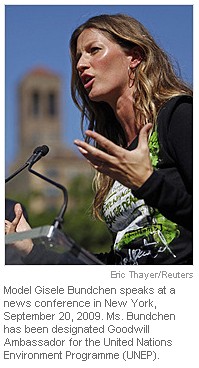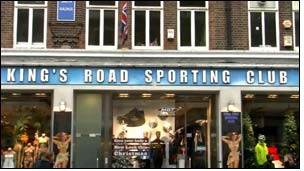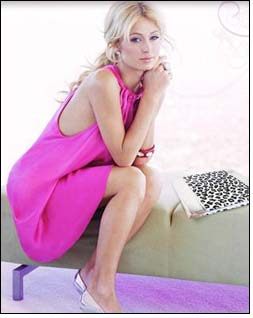 Paweł Lewandowski
Paweł Lewandowski Hedvig
Hedvig Rebekah Wing
Rebekah Wing Nhi Py
Nhi Py Mallory W
Mallory W

Once in the back rows, online reporters are shaking up traditions
Not everyone thought it was adorable in September when a 13-year-old wunderkind blogger named Tavi was given a front-row seat at the fashion shows of Marc Jacobs, Rodarte and others.
Oh now, do not misunderstand. She was totally adorable. You could have gobbled her up, with her goofy spark plug style -- a Peggy Guggenheim for the Tweeting tween set. Her feet, in designer stockings, did not quite touch the ground. Within a matter of months, Tavi Gevinson, the author of a blog called Style Rookie, was being feted by designers, filming promotions for Target, being flown to Tokyo for a party with the label Comme des Garçons and writing a review of the collections for no less than Harper's Bazaar. Kate and Laura Mulleavy, the designers of Rodarte, described her in the pages of Teen Vogue as ``curious and discerning.'' Rather, it was what the arrival of Ms.
Gevinson, as a blogger, represented that ruffled feathers among the fashion elite. Anne Slowey, who has spent decades climbing the editorial ladder to a senior position at Elle, dismissed the teenager's column as ``a bit gimmicky'' in an interview with New York magazine. And in an instant, the subtext in her complaint was read by dozens of Ms. Gevinson's fans as an example of the tension between old media and new, when one leapfrogs ahead of the other.
As a relatively new phenomenon in the crowded arena of journalists whose specialty it is to report the news of the catwalks, fashion bloggers have ascended from the nosebleed seats to the front row with such alacrity that a longheld social code among editors, one that prizes position and experience above outward displays of ambition or enjoyment, has been practically obliterated.
After all, what is one to think -- besides publicity stunt -- when Bryan Boy, a pseudonymous, style-obsessed blogger from the Philippines, is seated at the D & G show in Milan between the august front-row fixtures of Vogue and Vanity Fair, a mere two positions to the right of Anna Wintour?
There has been a complete change this year,'' said Kelly Cutrone, who has been organizing fashion shows since 1987. ``Do I think, as a publicist, that I now have to have my eye on some kid who's writing a blog in Oklahoma as much as I do on an editor from Vogue?
Absolutely. Because once they write something on the Internet, it's never coming down. And it's the first thing a designer is going to see.'' Perhaps it was to be expected that the communications revolution would affect the makeup of the fashion news media in much the same way it has changed the broader news media landscape. At a time when magazines like Vogue, W, Glamour and Bazaar have pared their staffs and undergone deep cutbacks because of the effect of the recession on their advertising sales, blogs have made remarkable strides in gaining both readership and higher profiles.
At the shows this year, there were more seats reserved for editors from Fashionista, Fashionologie, Fashiontoast, Fashionair and others, and fewer for reporters from regional newspapers that can no longer afford the expense of covering the runways independently.
But it is somewhat surprising that designers are adjusting to the new breed of online reporter more readily than magazines, which have been slow to adapt to the demand for instant content about all things fashion. Blogs are posting images and reviews of collections before the last model leaves the runway, while magazine editors are still jockeying to feature those clothes in issues that will be published months later.
So it is not without reason that some editors feel threatened, or that seasoned critics worry that they could be replaced by teenagers. The designers and publicists who once quivered before the mighty pens are now courting writers from Web sites that offer a direct pipeline to potential customers.
Sure, magazines and newspapers have started their own blogs and tweets, but reading them you often sense a generational disconnect, something like the queasy feeling of getting a friend request from your mother on Facebook.
(From Glamour.com: ``Dating Tips: Why It's Important to Get That Number.'') Sites that include readers in the conversation are thriving, in a sense democratizing the coverage of style, much as designers and retailers -- with lower priced fast-fashion collections -- have democratized fashion itself. Garance Doré and Scott Schuman, two photographers who have become stars online (and who are a couple offline), have created popular blogs with the simple idea of posting images of stylish people and opening them to public comment. Now designers are seeking their advice on communications strategies and even design -- Ms. Doré and Mr. Schuman have worked on projects with Gap.
Other sites have gained credibility along with traffic. Fashionista.com had 103,512 unique visitors in November, and Fashionologie.com had 27,125, according to the online tracking agency Compete. Jezebel.com (a saucy blog that includes coverage of fashion) shot ahead of Style.com (the Condé Nast fashion site) for the first time this autumn with more than a half-million visitors. These are considered large audiences for dispatches on such trivial developments as models' refusing to wear Alexander McQueen's crazy shoes or such-and-such designer's search for an intern.
The personalities behind those sites, in turn, are becoming as famous as some magazine editors. Marc Jacobs named one of his bag designs after Bryan Boy, while Sephora asked Lauren Luke, whose makeup videos are an Internet sensation, to preside over beauty contests in its stores. Designers are thinking differently in response to consumers who want instant gratification.
Doo-Ri Chung, for example, describing her new basics collection in The Financial Times this autumn, said her customer had a ``blog mentality, not a magazine mentality.'' ``The old idea of reading a magazine and planning ahead, that's not something that younger customers do,'' she said. ``It's a different world, and designers have to adapt.'' Still, the popularity and novelty of such sites have raised concerns that their writers might be unduly influenced by designers or beauty companies. New guidelines from the Federal Trade Commission, announced in October, require blogs to disclose in their online product reviews whether they receive free merchandise or payment for the items they write about. This bothered some bloggers, and reasonably so, since magazine editors commonly receive stockpiles of the same expensive goodies to review in their pages and that practice is rarely disclosed, even though magazines are beholden to advertisers for their livelihood.
Those guidelines also seem excessive at a time when magazines and newspapers are changing their tone to embrace the online culture. On several fashion sites last week, it was reported that Vogue was planning to feature a group of bloggers in its March issue, including Tommy Ton of Jak & Jil, Ms. Doré and, yes, even Bryan Boy.
 From Audrey Hepburn to Bob Geldof to Bono, hands-on humanitarian work has long held an appeal for stars who want to give something back. Yet, for all the celebrities in charity, the rarified world of fashion has tended to shun this spotlight.
From Audrey Hepburn to Bob Geldof to Bono, hands-on humanitarian work has long held an appeal for stars who want to give something back. Yet, for all the celebrities in charity, the rarified world of fashion has tended to shun this spotlight.
Perhaps an active interest in gritty issues does not seem like such a leap for rock stars — balladeers who speak to the heart and keep it real on the road — or serious actors like, say, George Clooney (messenger of peace for the U.N.) in “Syriana” or Angelina Jolie (good-will ambassador for the U.N. Refugee Agency) in “A Mighty Heart.”
For fashion models, whose caché depends on radiating exclusivity, luxury and expense, hard-core charity work is arguably a less natural mix. With a few exceptions, like Claudia Schiffer’s work for Unicef, fashion celebrities have been reluctant to get their hands dirty. Chic fund-raising events, yes; speaking out at rallies and visiting remote, poverty-struck villages, no.
Yet, in recent years, as environmental concerns have pushed ecological and ethical luxury into the vogue, so, too, the fashion world has moved closer to the more practical side of humanitarian work. This new embrace was made all the tighter by celebrity models who are going back to their roots and by the global economic crisis, which caused many luxury brands to teeter as the public’s values moved away from thoughtless spending and toward more frugal tastes.
“Nowadays, it is almost expected from celebrities to support some cause,” said Marissa Buckanoff, the chief of Unicef’s celebrity relations and partnership section in New York, pointing out that humanitarian work is now seen as a celebrity duty, regardless of whether the fame comes from music, movies or fashion.
In Africa, the continent whose distress stands at greatest odds with fashion, Tasha de Vasconcelos, a former supermodel and the current face of Nivea, opened a maternity ward in Kasese, Malawi, in April this year, with the support of Louis Vuitton.
“Maybe it wasn’t so in fashion to be thinking about these causes before, but it’s almost been forced,” she said. “We’re in a different era now. Since the fall of Lehman Brothers, we are responsible to partnerships, to giving and to sharing with others”
Ms. de Vasconcelos, born in Beira, Mozambique, is familiar with poverty and civil war. The daughter of a Portuguese father and English mother, she was eight when Portugal pulled out of its former colony and civil unrest erupted. The family fled to Zimbabwe, and, then, after Ms. de Vasconcelos’s grandfather was killed by guerillas, to Canada, arriving in 1980 when she was 13 years old.
Spotted by the Elite model agency in Canada at 19, her modeling career blossomed as she was photographed by Steven Meisel for Vogue and began working for labels like Dior and Yves Saint Laurent. As her celebrity profile grew, she said, so did her desire to give something back to the troubled continent of her birth.
Ms. de Vasconcelos is not alone among celebrity models wanting to use their fame to help their roots. As fashion tastes moved from the 1990s look of Western healthfulness (Cindy Crawford, Helena Christensen) or urban waifs (Kate Moss, Audrey Marnay) to the current demand for more diversified faces on the catwalk — Slavic, African, Latino — so the origins of the supermodels have also expanded.
Gisele Bündchen’s work to protect rain forests in her native Brazil led her to being named good-will ambassador for the U.N. Environment Program in September. The Sudanese-born supermodel Alek Wek works to help raise health standards in that country. The supermodel Natalia Vodianova, who was discovered in a Russian market where she worked as a teenager in part to help raise her disabled sister, has raised money for her Naked Heart Foundation, which builds playground parks for Russian children.
Ms. Vodianova works in partnership with Calvin Klein; LVMH has long had a list of humanitarian causes that it supports.
For Ms. de Vasconcelos, the desire among models to go back to their origins is natural: “The circumstances of my birth never left me,” she says.
In the 1990s, Ms. de Vasconcelos began working as a volunteer for Unicef and in 1996 started collaborating with Nelson Mandela’s Children’s Fund. Then, in 2006, using the support of contacts she had made through her fashion career, she founded AMOR, a charity to reduce infant and maternal mortality rates, starting with Africa.
The charity’s first project — the maternity ward in Kasese — was opened in collaboration with Chris Brooks, a Canadian doctor who had founded two hospitals and a clinic in Malawi under his Lifeline Malawi charity. All nurses at AMOR’s clinic are Malawian, trained by Dr. Brooks’s team and paid by AMOR, said Ms. de Vasconcelos, who has undertaken to support the ward for at least three years. The charity’s next mission is to develop the “Collegio Enfantil,” an orphanage on the Mozambique street on which Ms. de Vasconcelos was born.
The notoriously tough world of modeling, where rejection is a daily reality, provides good training for models’ fund-raising efforts. Romanticism is not what raises funds, and Ms. de Vasconcelos, who has to find €64,000, or $92,000, a year for the maternity clinic, acknowledges the need for toughness. “It’s part Mother Teresa, part entrepreneur,” she said. “It’s not like I have a huge public behind me. Yes, a few powerful men of industry at the start” — supporters at AMOR’s founding included Paul Newman and Prince Albert of Monaco — “but you have to make it concrete.”
Her hard work is yielding results. In April, Ms. de Vasconcelos was named ambassador for the Institut Pasteur, a French nonprofit foundation, and in November she was asked by José Manuel Barroso, the president of the European Commission, to become the face of humanitarian issues for the E.U.
France Télévisions, the French public national television broadcaster, has just finished shooting a 60-minute documentary on her life, which she hopes will raise awareness of AMOR. And another “major fashion house” (she asked to withhold its name until the alliance became official) has pledged support to the charity. And humanitarian work seems to have raised her own profile as model. “My force has clearly moved beyond fashion,” she said. “And I’m being looked at more seriously in the fashion world, perhaps because of that.”
Meanwhile, successful fund-raising meant that Ms. de Vasconcelos was able last month to open a new wing for the Malawian maternity clinic. (She did it wearing Vuitton. “You have to show both: It’s one that brings the other,” she said, explaining that her glamorous image attracts the funding and attention.) Since the clinic opened, the transmission rate from HIV-positive mothers to their children in Kasese has gone from 8 out of 8 to 1 out of 8, Ms. de Vasconcelos said.
“Everything is falling into place this year,” she said. “This is the year when the journey of beauty joined with the journey of credibility.”
Kate Moss, Catherine Zeta-Jones and Elizabeth Hurley are used to dominating society's best-dressed lists. But this week they will find themselves topping a more dishonourable fashion list.
The People for the Ethical Treatment of Animals (Peta) Foundation has drawn up a roll call of the fashion world's Worst Dressed Celebrities based on their penchant for pelts. The Duchess of Cornwall and Shirley Bassey will also grace the list, as will football Wags Coleen Rooney and Alex Gerrard, and the singer Rihanna.
The "winner", to be chosen in an online poll, will be announced in February by Stella McCartney, a vegetarian who refuses to use any leather and fur in her designs.
The award is considered to be a powerful weapon in the fight against fur. Last year Paris Hilton and Christina Ricci announced a change of heart about wearing it after being nominated. "I never meant to hurt nor anger anyone with my insensitivity," said Ricci. "For what it is worth, I have received the message loud and clear and will not be wearing fur in the future. I apologise for my offensive actions."
Moss is hot favourite to win this year in recognition of her collection of fur coats, sealskin Mukluk boots, rabbit-skin bedspreads and sheepskin rugs. Elizabeth Hurley is also tipped as a likely winner after agreeing to pose in a selection of mink coats for fur house Blackglama.
"Among the most vulgar offenders this year is Catherine Zeta-Jones, who can't seem to leave her room in New York without covering herself head to toe in the dried-out skins of several species – not just fur coats but leather pants and crocodile bags," said Dan Mathews, vice-president of Peta. "She looks more like a serial killer than a star.
"We've written to Rihanna in the hope that the furs she's been flaunting are fake, but it seems the cat's got her tongue," he added. "The Duchess of Cornwall, not to be thwarted by the fox-hunting ban, has gone hunting in her grannie's wardrobe. Then there's the old guard like Shirley Bassey, who has a skin-crawling fashion sense. Elizabeth Hurley's wardrobe is now as dead as her film career."
A growing list of fashion icons have sworn off fur, from Carla Bruni and Michelle Obama to Pink and Lady Gaga. But times have changed since the early 1990s, when supermodels such as Naomi Campbell declared they would rather go naked than wear fur. Now Campbell fronts a campaign for the furrier Dennis Basso – and campaigners admit that, on the catwalk and the high street, the trend is hotter than it has been for years.
Fur coats made an appearance during the New York, London and Milan fashion weeks. Karl Lagerfeld covered motorcycle helmets with mink and chinchilla. Dolce & Gabbana added bright pink fur sleeves to jackets. Fur also featured prominently in the collections of Louis Vuitton, Fendi and Prada.
Last month French Vogue featured the Brazilian supermodel Raquel Zimmermann in a flurry of fur. Keira Knightley attended an awards ceremony in a karakul lambskin coat and Jennifer Lopez makes no secret of her fondness for mink and chinchilla.
Anna Wintour, editor-in-chief of American Vogue, is unapologetically pro-fur, running positive editorials and fur-themed photo shoots. "Fur is still part of fashion," Wintour said this year, "so Vogue will continue to report on it."
Celebrities' enthusiasm for fur has seen sales rocket. In 2007, fur sales worldwide totalled $16.5bn, up by 11% on the previous year, following nine years of continuous growth. Last year the fur trade contributed $21bn to the global economy.
Campaigners admit they are concerned that the industry is winning its fight to redefine fur as something worn by chic, edgy kids rather than the sort of moth-eaten, fusty choice made by traditional grandmothers.
"Young people are more comfortable showing their love of fur," said Mathews. "Hopefully, our Worst Dressed Award will wake these cold-hearted celebs up to the truth about fur."
 KRSC provides a large number of A-list celebrities and even royalty with everything they need to get fit while looking great.
KRSC provides a large number of A-list celebrities and even royalty with everything they need to get fit while looking great.
KRSC’s Store Manager, Anne Bartlett, knows better than anyone the fitness secrets of the stars and here she unveils a few of the celebrity fitness activities that will be big in 2010 and what the stars will be wearing whilst they get into shape.
Camron Diaz - Running
Cameron loves to wear bra tops and running leggings from Casall to show off her figure. Products are made with technical fabrics to whip away sweat, and bra tops have a mesh cross back, which allows the body to breath.
Liv Tyler – Hula Hoop
Liv opts for fitted clothes for her workouts. Her favourite styles include Beyond Yoga and she uses the weighted Casall hula hoop to give her even more of a work out. Look out for the cross back tank top and great fitted leggings.
Kate Hudson – Spinning
Kate loves cycling and attends spinning classes to keep fit. Gore bike wear is her brand of choice. She opts for fitted tops with built in support and padded cycling shorts for intensive sessions on the bike.
The store also caters for ‘Yogistas’ – stocking a wide range of equipment, accessories and clothing for all types and intensities of traditional and contemporary yoga styles including Bikram (Hot Yoga).
Anne Bartlett also takes us through her selection of the best of the latest yoga gear and clothing that will be available for 2010.
Lululemon Athletica Groove Pant
All purpose low impact sports pant with waistband pocket for gym cards and Coolmax gusset designed for comfort. This pant is made of a quickdry material (Luon), is also reversible and comes in both regular and tall leg lengths
Lululemon Athletica Define Jacket
A versatile all sport warm up jacket made from Luon that is meant to fit close to the body. The best design feature is the back vent- it makes you waist look so small!
Casall Fancy Tank Top
This tank has built in support with a clean and feminine style as well as great moisture management as it is made from RapidDry fabric. Perfect for the gym, tennis or golf!
Zenzation Pure Earth Eco Yoga Mat
A 4mm 2 tone yoga mat. It is moisture and bacterial resistant and 60% lighter than standard PVC mats. Most important- it is Earth friendly and 100% biodegradable and recyclable.
Tonic Hot Pants & Bra Top
Made from Supplex, this set is not only functional but also really fashionable. It’s a must for anyone trying Bikram or hot yoga where clothing should be kept to a minimum!
Finally Whether you are running for fitness or marathon training KRSC has one of London’s best stocked running departments with footwear brands including Asics, New Balance and Mizuno and apparel from Gore, SKINS and Nike to name a few. Head Buyer David Conitzer, himself a keen runner, has selected his top running product picks for the New Year.
ASICS GEL KAYANO 16
High mileage trainer that blends cushioning and stability
Polar S1 Foot Pod and RS800CX Watch Accurately measures your running speed, distance, cadence, heart rate and calories burned. A GPS unit can also be bought separately.
CW-X Running Tights The Stabilyx Tights offer targeted support to protect your knees joints, lower back and core area so you can run strong with less fatigue.
Odlo Evolution Top
A seamless, lightweight top with hi-tech climate regulation and moisture management
Gore High visibility running jacket and running vest
A packable, lightweight, Windstopper jacket that offers breathability and water resistance, combined with hi-visibility for the dark winter months.
Reflective on the front and back
Garmin Forerunner 405 Watch
Wireless and GPS enabled watch, calculates time, distance and pace and sends the information directly to you computer
For more information on the latest fitness gear and to see a wide range of exclusive, performance activewear brands visit KRSC at 38-42 King’s Road London, where friendly, informative staff are on hand with advice on what you need to get fit and look great in 2010.

A woman shops for toys at a Wal-Mart Supercenter in Denver, Colorado. Merchants are facing big hurdles to lure shoppers back in January amid lean inventories. Bloomberg News
Economy in 'stable condition' as retail sales increase 3.6 percent
NEW YORK: Holiday shoppers in the United States spent a little more this season, according to data released yesterday, giving merchants some reason for cheer.
The spending bounce means retailers managed to avoid a repeat of last year's disaster even amid tight credit and double-digit unemployment. Profits should be healthier too, because stores had a year to plan their inventories to match consumer demand and never needed to resort to fire-sale clearances.
Retail sales rose 3.6 percent from Nov 1 through Dec 24, compared with a 3.2 percent drop in the year-ago period, according to figures from MasterCard Advisors' SpendingPulse, which track all forms of payment, including cash.
Adjusting for an extra shopping day between Thanksgiving and Christmas, the number was closer to a 1 percent gain.
Last year, the economy was in "critical condition", said Michael McNamara, vice-president at MasterCard Advisors' SpendingPulse. "This year, it's in stable condition."
A major winter storm that slammed the Northeast and shut in shoppers on the Saturday before Christmas derailed sales. But consumers appeared to have made up for the loss by shopping in advance of the storm and the days leading up to Christmas.
"We had a pretty decent surge," McNamara said.
Online sales were a particular hot spot, fueled by a big increase the weekend before Christmas. They rose 15.5 percent on the season, though they make up less than 10 percent of all retail sales.
One worrisome sign: Merchants are facing big hurdles to lure shoppers back in January amid lean inventories and what appear to be weak gift card sales. Gift card sales are recorded only when they are redeemed.
Stores count on a post-Christmas boost because of the growing importance of January on the retail sales calendar. Last year, the week after Christmas accounted for 15 percent of overall holiday sales, according to ShopperTrak, a research firm.
Retail consultant Burt P. Flickinger describes gift cards as "the lifeblood" of the post-Christmas season, because shoppers typically spend more than the value of the cards.
"Retailers with a disappointing December are going to need January to survive," Flickinger said. "Inventories are even too low for retailers."
Karen MacDonald, a spokeswoman at Taubman Centers Inc, said a survey among its centers this past weekend showed that merchants are on track to generate on average low single-digit sales increases from a year ago, though they still have a week to go.
MacDonald noted that the centers had a strong last-minute sales surge, and this past weekend, business has been strong. She added that 85 percent of shoppers are buying, 10 percent are exchanging and about 5 percent are returning items.
Weaker area included luxury items, whose 0.8 percent increase came nowhere near making up for last year's 20 percent decline. Apparel sales fell 0.4 percent on top of a 19 percent decline last year.
A full picture of how individual retailers did will not be known until Jan 7, when many report December sales.
Twenty-two local clothing companies in Jordan will participate in a project named JMODA with the Italian authorities to help small and medium scale enterprises (SMEs) grow their businesses in national and international markets by offering specialised technical support and training.
"The selected companies will be provided with technical support to upgrade their capabilities to enable local manufacturers to export high quality products to the European markets," said Garment Design and Training Services Centre CEO Raghad Al Khoja.
Japanese fibre maker Teijin has sold out its Indonesian subsidiary as part of restructuring of its polyester fibres business due to stiff competition from China over the last decade.
The new owners of PT Teijin Indonesia Fiber Tbk (TIFICO) are PT Prospecto Motor, PT Hermawan Sentral Investama, PT Wiratama Karya Sejati and Pioneer Atrium Holding Ltd - all of which have textile manufacturing interests.
Teijin explained why the company sold the polyester unit: "It achieved a level of profit lower than expected."

Eva Longoria Parker is joining the celebrity perfume trend - she's landed a deal to launch her own fragrance. The Desperate Housewives star has teamed up with the Falic Fashion Group to create Eva by Eva Longoria, which is due to launch in the U.S. in the spring (10).
Longoria Parker admits she's always struggled to find a perfume to wear and was delighted to be handed the opportunity to create her own scent.
She says, "I have always been somewhat allergic to all perfumes and really wanted to create something that every woman could wear. So I decided to create my own fragrance that is light, fresh and unique. I think the scent of a woman is extremely sexy and this scent will prove that.”
The company plans to release a series of different fragrances under the Eva Longoria brand.
The actress follows in the footsteps of stars including Jennifer Lopez, Christina Aguilera, Britney Spears and Sarah Jessica Parker who all have their own successful perfume lines.

The Creativity Collection by Paris Hilton is now available at Zellers across Canada! The whole line was created and designed for teens and young adults. The line consists of scrapbooking accessories, albums and embellishments for the consumer to personalize their memories, objects and fashion accessories.
"I am so excited to be working with Wooky Entertainment to launch Paris Hilton, the Creativity Collection in Canada," explained Paris Hilton. "These fashion kits reinforce creativity and individual style. I hope my collection will inspire young women and give them a greater sense of accomplishment and self confidence."
Paris Hilton is doing a monthly blog on scrapbooking.com. In December, Paris is showing us a gift box she made for her sister Nicky for Christmas with the scrapbooking layout concept. "The gift box is a fun and easy way for everyone to add a personal touch to a gift. It's easy and so appreciated." In January, Paris will share with her fans and other scrappers the importance of high self-esteem.
Traditional batik producers in Cirebon, West Java, have demanded that the government protect the batik industry from competition from textile imports from China.
Batik industry lobbyist Katura warned the government of the influx of Chinese textiles with batik motifs.
He said people would rather buy Chinese textiles because they were cheaper and had a wider range of designs. "Without concrete measures, Chinese-made batik could displace traditional batik, including Trusmi batik, which hails from Cirebon's coastal area."
Quality-wise, Katura said, traditional batik was superior, but its higher pricing and weak marketing pushed many people to buy China-made batik.
He said the government should take seriously the threat to traditional batik, which he said was an integral part of the nation's cultural heritage.
"We urge the government not to procrastinate and downplay effects from the influx of Chinese-made batik.
"I have received reports Chinese-made batik is being sold in markets in Semarang and Surakarta at cheaper prices. This is a cause for concern," Katura said.
He also expressed concern that higher volumes of Chinese-made batik would push aside traditional batik. "It would certainly put traditional batik producers, as well as Indonesians in general, at a disadvantage," he said.
With 700 batik producers, Trusmi village in Plered district, Cirebon regency, is the biggest batik production center in West Java. "Apart from preserving our cultural heritage, batik is also the main source of income for people in Trusmi. If the government doesn't protect this tradition, the villagers could lose their livelihoods," Katura said.
The West Java provincial administration has promised to support and protect traditional batik from Chinese competition.
"We will help protect traditional batik and its artisans from foreign competitors, such as batik motif textiles from China. We are committed to preserving batik as a national heritage," Ano Sutrisno, head of the West Java Administrative and Development Coordinating Agency (BKPP) regional III, said.
The BKPP regional III assists the West Java governor in coordinating the administration and development of Majalengka, Indramayu, Kuningan and Cirebon regencies, and Cirebon city.
Ano said protecting traditional batik would begin by exposing batik producers to a wider market. "We will help market batik domestically and internationally. Hopefully this will help counteract impacts from the influx of foreign products," he said.